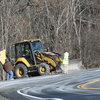DEC says CWD is controlled
WESTERLO With the 2005 hunting season in the rearview mirror, the New York State Department of Environmental Conservation says the deer population is stabilizing after a harsh winter three years ago, and efforts to control the deadly chronic wasting disease are working.
Some local sportsmen, however, complain that a DEC ban on feeding, meant to stop the spread of disease, has weakened the herd in Albany County.
Jack Milner, president of the Whitetail Association, a Westerlo-based hunting group, called the ban "the DEC’s tragic mistake" in a letter to the Enterprise editor.
Chronic wasting disease (CWD), which affects deer, elk, and moose, attacks the nervous system, causing the animals to become emaciated, lose body function, and die. Health officials say CWD does no harm to humans or other animals, but recommend people avoid eating venison from unhealthy deer.
CWD was first detected in the United State in an elk herd in South Dakota in 1997. Since then, 25 more elk herds and three deer herds have tested positive for the disease, mostly in the western states.
Despite precautions taken by the state, CWD was detected in New York in March of 2005, first in two captive herds in Oneida County, and soon after in a wild deer in the same area. The DEC immediately moved to contain the disease, establishing mandatory check stations in Oneida County and parts of Madison County, and restricting the transport of certain deer parts out of the area.
To monitor the disease, the DEC began a sampling program, and has since tested over 8,000 deer in New York, including 2,800 in Oneida and Madison counties.
To date, DEC spokesperson Maureen Wren told The Enterprise, the state hasnt found any more instances of CWD.
"We’re going to continue to be monitoring it," she said.
Even before CWD was detected in New York, in 2002 when it reached Wisconsin, the DEC enacted regulations, including restricting the importation of deer and elk into the state and forbidding the feeding of wild deer.
At the same time, the New York State Department of Agriculture and Markets established a herd health-certification program for deer farms. Deer farmers are not allowed to move their herds or members of their herds without permission from the department of agriculture.
In the 2005 season, hunters took 14 percent fewer deer in New York than the previous year. However, the DEC deliberately issued 35 percent fewer permits. After a brutal winter in 2002-03, Wren said, the state is trying to stabilize the population, which had swelled to an unsustainable size prior to the winter of 2002.
The population is still too high or too low in some places, she said.
In Albany County, hunters took 2,118 deer in 2005, compared to 2,288 the year before. In Wildlife Management Unit 4H, which includes most of the Hilltowns, the DEC was aiming for hunters to take 2.2 bucks per square-mile in 2005, and hit its mark exactly.
Any significant decrease in herd size is mostly due to harsh conditions, Wren said, not the feeding ban. The DEC stands by the ban, she said, because its helps fights disease by preventing the unnatural congregation of deer.
Scientists believe CWD is spread through contact with saliva, feces, and urine, as well as indirect contact through environmental contamination.


